Zhewei Yao
BiFeat: Supercharge GNN Training via Graph Feature Quantization
Jul 29, 2022



Abstract:Graph Neural Networks (GNNs) is a promising approach for applications with nonEuclidean data. However, training GNNs on large scale graphs with hundreds of millions nodes is both resource and time consuming. Different from DNNs, GNNs usually have larger memory footprints, and thus the GPU memory capacity and PCIe bandwidth are the main resource bottlenecks in GNN training. To address this problem, we present BiFeat: a graph feature quantization methodology to accelerate GNN training by significantly reducing the memory footprint and PCIe bandwidth requirement so that GNNs can take full advantage of GPU computing capabilities. Our key insight is that unlike DNN, GNN is less prone to the information loss of input features caused by quantization. We identify the main accuracy impact factors in graph feature quantization and theoretically prove that BiFeat training converges to a network where the loss is within $\epsilon$ of the optimal loss of uncompressed network. We perform extensive evaluation of BiFeat using several popular GNN models and datasets, including GraphSAGE on MAG240M, the largest public graph dataset. The results demonstrate that BiFeat achieves a compression ratio of more than 30 and improves GNN training speed by 200%-320% with marginal accuracy loss. In particular, BiFeat achieves a record by training GraphSAGE on MAG240M within one hour using only four GPUs.
ZeroQuant: Efficient and Affordable Post-Training Quantization for Large-Scale Transformers
Jun 04, 2022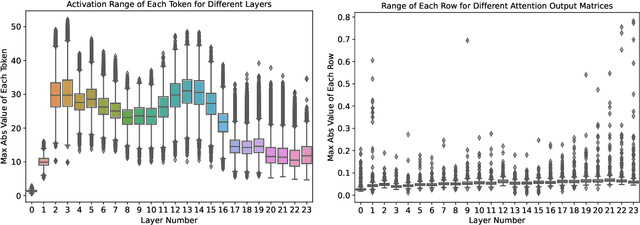



Abstract:How to efficiently serve ever-larger trained natural language models in practice has become exceptionally challenging even for powerful cloud servers due to their prohibitive memory/computation requirements. In this work, we present an efficient and affordable post-training quantization approach to compress large Transformer-based models, termed as ZeroQuant. ZeroQuant is an end-to-end quantization and inference pipeline with three main components: (1) a fine-grained hardware-friendly quantization scheme for both weight and activations; (2) a novel affordable layer-by-layer knowledge distillation algorithm (LKD) even without the access to the original training data; (3) a highly-optimized quantization system backend support to remove the quantization/dequantization overhead. As such, we are able to show that: (1) ZeroQuant can reduce the precision for weights and activations to INT8 in a cost-free way for both BERT and GPT3-style models with minimal accuracy impact, which leads to up to 5.19x/4.16x speedup on those models compared to FP16 inference; (2) ZeroQuant plus LKD affordably quantize the weights in the fully-connected module to INT4 along with INT8 weights in the attention module and INT8 activations, resulting in 3x memory footprint reduction compared to the FP16 model; (3) ZeroQuant can be directly applied to two of the largest open-sourced language models, including GPT-J6B and GPT-NeoX20, for which our INT8 model achieves similar accuracy as the FP16 model but achieves up to 5.2x better efficiency.
Extreme Compression for Pre-trained Transformers Made Simple and Efficient
Jun 04, 2022

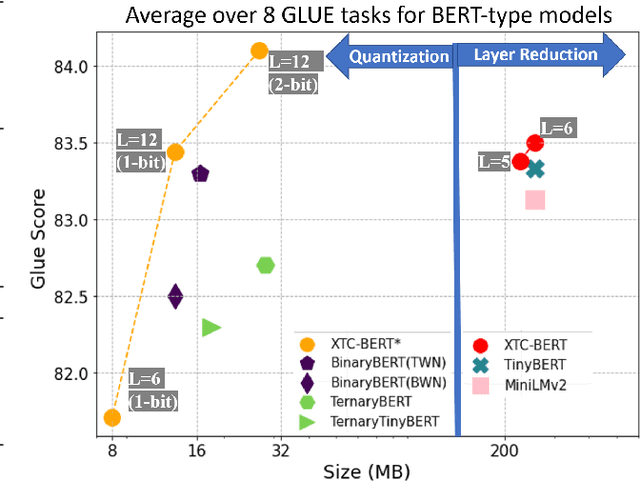

Abstract:Extreme compression, particularly ultra-low bit precision (binary/ternary) quantization, has been proposed to fit large NLP models on resource-constraint devices. However, to preserve the accuracy for such aggressive compression schemes, cutting-edge methods usually introduce complicated compression pipelines, e.g., multi-stage expensive knowledge distillation with extensive hyperparameter tuning. Also, they oftentimes focus less on smaller transformer models that have already been heavily compressed via knowledge distillation and lack a systematic study to show the effectiveness of their methods. In this paper, we perform a very comprehensive systematic study to measure the impact of many key hyperparameters and training strategies from previous works. As a result, we find out that previous baselines for ultra-low bit precision quantization are significantly under-trained. Based on our study, we propose a simple yet effective compression pipeline for extreme compression, named XTC. XTC demonstrates that (1) we can skip the pre-training knowledge distillation to obtain a 5-layer BERT while achieving better performance than previous state-of-the-art methods, e.g., the 6-layer TinyBERT; (2) extreme quantization plus layer reduction is able to reduce the model size by 50x, resulting in new state-of-the-art results on GLUE tasks.
DeepSpeed-MoE: Advancing Mixture-of-Experts Inference and Training to Power Next-Generation AI Scale
Jan 14, 2022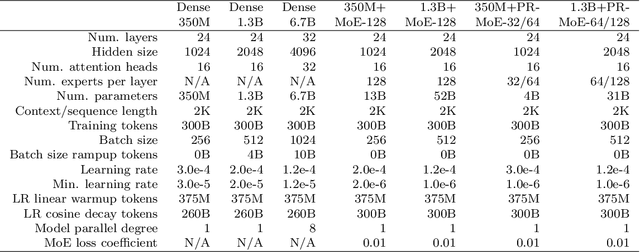
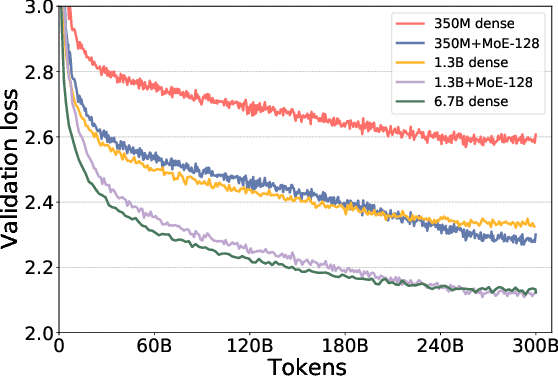
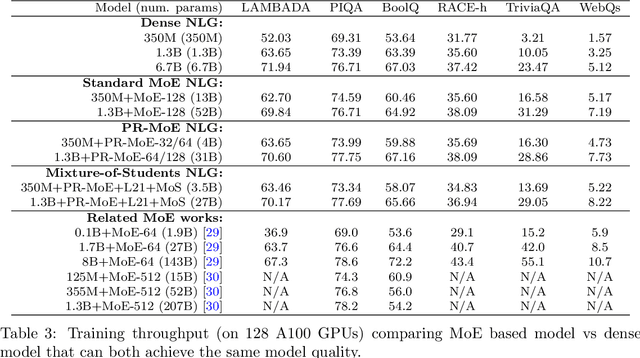
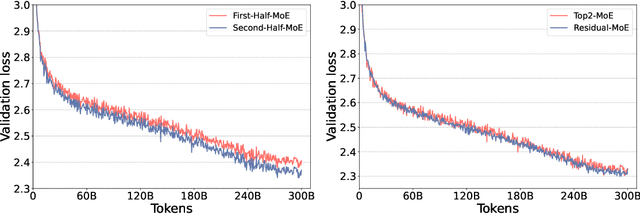
Abstract:As the training of giant dense models hits the boundary on the availability and capability of the hardware resources today, Mixture-of-Experts (MoE) models become one of the most promising model architectures due to their significant training cost reduction compared to a quality-equivalent dense model. Its training cost saving is demonstrated from encoder-decoder models (prior works) to a 5x saving for auto-aggressive language models (this work along with parallel explorations). However, due to the much larger model size and unique architecture, how to provide fast MoE model inference remains challenging and unsolved, limiting its practical usage. To tackle this, we present DeepSpeed-MoE, an end-to-end MoE training and inference solution as part of the DeepSpeed library, including novel MoE architecture designs and model compression techniques that reduce MoE model size by up to 3.7x, and a highly optimized inference system that provides 7.3x better latency and cost compared to existing MoE inference solutions. DeepSpeed-MoE offers an unprecedented scale and efficiency to serve massive MoE models with up to 4.5x faster and 9x cheaper inference compared to quality-equivalent dense models. We hope our innovations and systems help open a promising path to new directions in the large model landscape, a shift from dense to sparse MoE models, where training and deploying higher-quality models with fewer resources becomes more widely possible.
What's Hidden in a One-layer Randomly Weighted Transformer?
Sep 08, 2021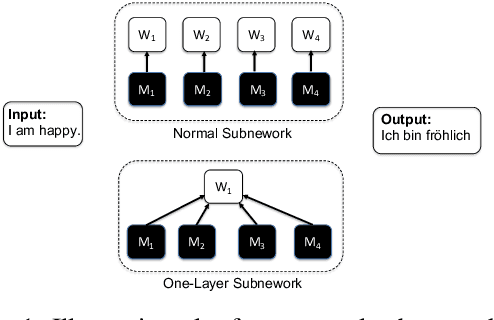
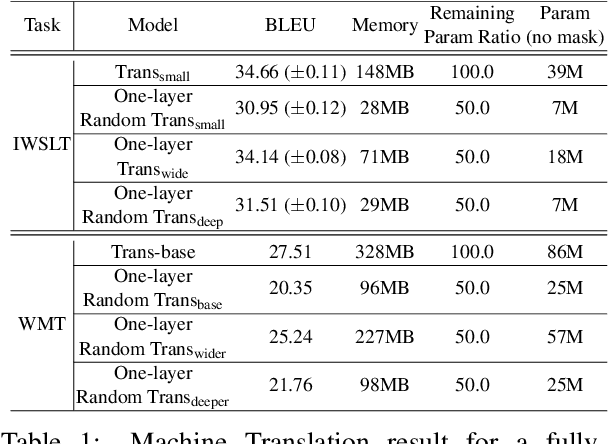
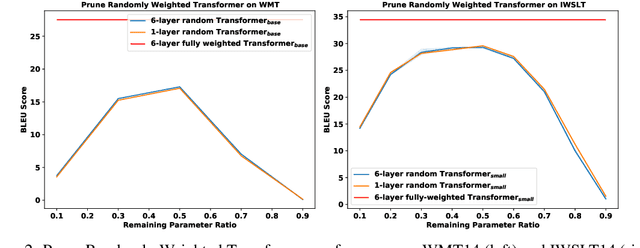
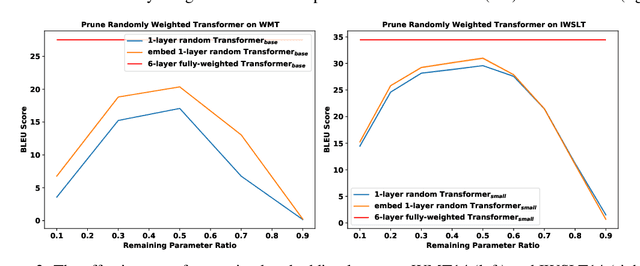
Abstract:We demonstrate that, hidden within one-layer randomly weighted neural networks, there exist subnetworks that can achieve impressive performance, without ever modifying the weight initializations, on machine translation tasks. To find subnetworks for one-layer randomly weighted neural networks, we apply different binary masks to the same weight matrix to generate different layers. Hidden within a one-layer randomly weighted Transformer, we find that subnetworks that can achieve 29.45/17.29 BLEU on IWSLT14/WMT14. Using a fixed pre-trained embedding layer, the previously found subnetworks are smaller than, but can match 98%/92% (34.14/25.24 BLEU) of the performance of, a trained Transformer small/base on IWSLT14/WMT14. Furthermore, we demonstrate the effectiveness of larger and deeper transformers in this setting, as well as the impact of different initialization methods. We released the source code at https://github.com/sIncerass/one_layer_lottery_ticket.
How Much Can CLIP Benefit Vision-and-Language Tasks?
Jul 13, 2021
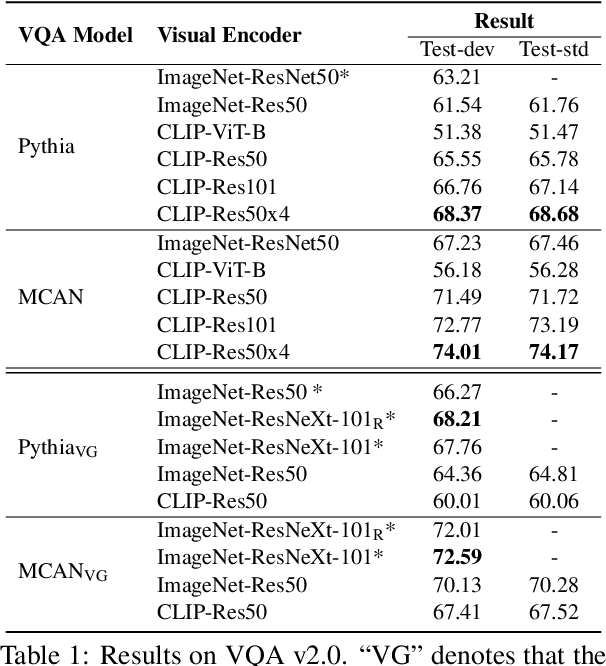
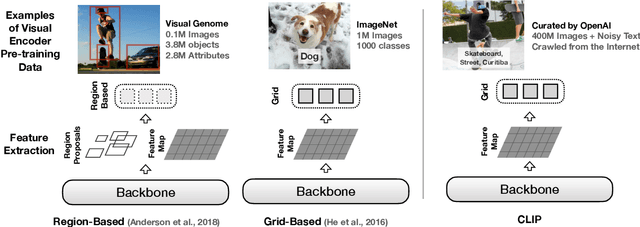
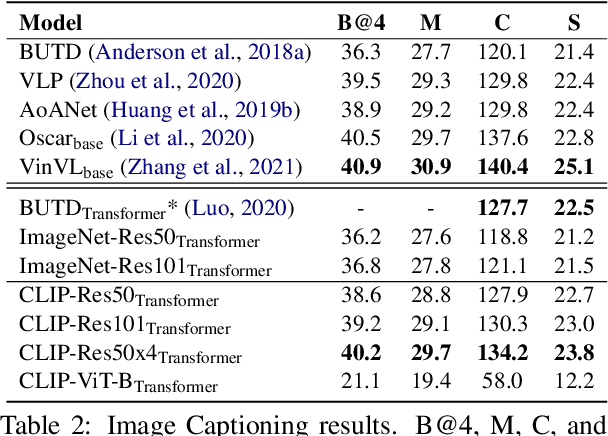
Abstract:Most existing Vision-and-Language (V&L) models rely on pre-trained visual encoders, using a relatively small set of manually-annotated data (as compared to web-crawled data), to perceive the visual world. However, it has been observed that large-scale pretraining usually can result in better generalization performance, e.g., CLIP (Contrastive Language-Image Pre-training), trained on a massive amount of image-caption pairs, has shown a strong zero-shot capability on various vision tasks. To further study the advantage brought by CLIP, we propose to use CLIP as the visual encoder in various V&L models in two typical scenarios: 1) plugging CLIP into task-specific fine-tuning; 2) combining CLIP with V&L pre-training and transferring to downstream tasks. We show that CLIP significantly outperforms widely-used visual encoders trained with in-domain annotated data, such as BottomUp-TopDown. We achieve competitive or better results on diverse V&L tasks, while establishing new state-of-the-art results on Visual Question Answering, Visual Entailment, and V&L Navigation tasks. We release our code at https://github.com/clip-vil/CLIP-ViL.
MLPruning: A Multilevel Structured Pruning Framework for Transformer-based Models
May 30, 2021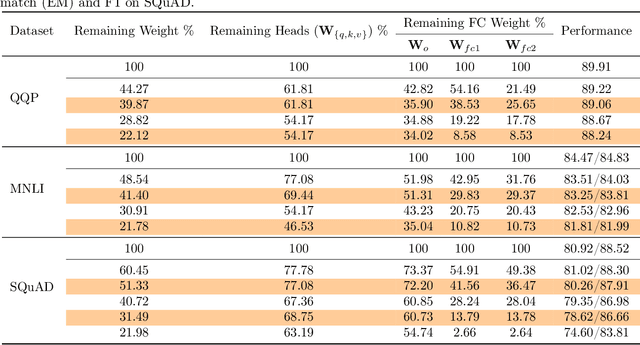
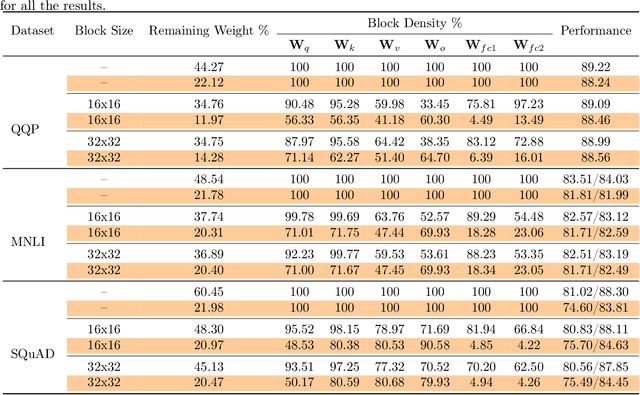
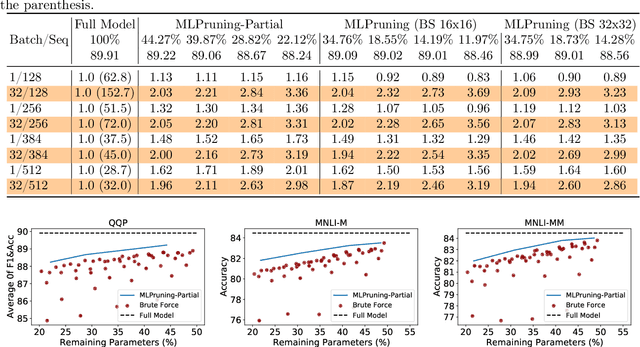

Abstract:Pruning is an effective method to reduce the memory footprint and computational cost associated with large natural language processing models. However, current approaches either only explore head pruning, which has a limited pruning ratio, or only focus on unstructured pruning, which has negligible effects on the real inference time and/or power consumption. To address these challenges, we develop a novel MultiLevel structured Pruning (MLPruning) framework, which uses three different levels of structured pruning: head pruning, row pruning, and block-wise sparse pruning. We propose using a learnable Top-k threshold, which employs an adaptive regularization to adjust the regularization magnitude adaptively, to select appropriate pruning ratios for different weight matrices. We also propose a two-step pipeline to combine block-wise pruning with head/row pruning to achieve high structured pruning ratios with minimum accuracy degradation. Our empirical results show that for \bertbase, with \textapprox20\% of remaining weights, \OURS can achieve an accuracy that is comparable to the full model on QQP/MNLI/\squad, with up to \textapprox3.69x speedup. Our framework has been open sourced~\cite{codebase}.
ActNN: Reducing Training Memory Footprint via 2-Bit Activation Compressed Training
Apr 29, 2021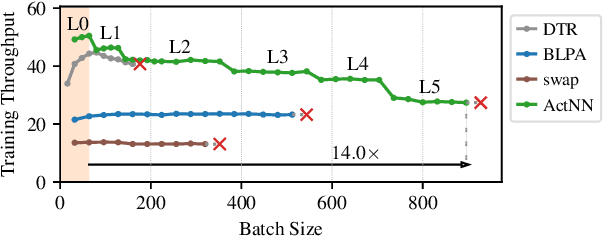
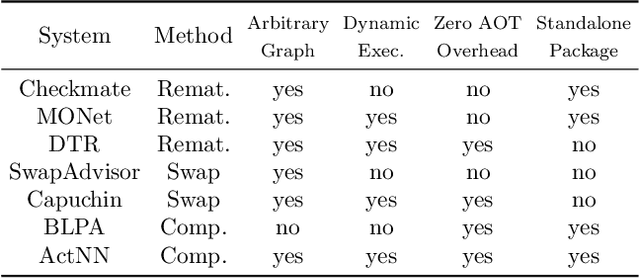

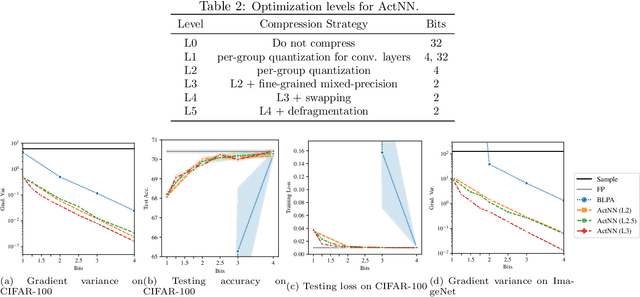
Abstract:The increasing size of neural network models has been critical for improvements in their accuracy, but device memory is not growing at the same rate. This creates fundamental challenges for training neural networks within limited memory environments. In this work, we propose ActNN, a memory-efficient training framework that stores randomly quantized activations for back propagation. We prove the convergence of ActNN for general network architectures, and we characterize the impact of quantization on the convergence via an exact expression for the gradient variance. Using our theory, we propose novel mixed-precision quantization strategies that exploit the activation's heterogeneity across feature dimensions, samples, and layers. These techniques can be readily applied to existing dynamic graph frameworks, such as PyTorch, simply by substituting the layers. We evaluate ActNN on mainstream computer vision models for classification, detection, and segmentation tasks. On all these tasks, ActNN compresses the activation to 2 bits on average, with negligible accuracy loss. ActNN reduces the memory footprint of the activation by 12x, and it enables training with a 6.6x to 14x larger batch size.
Q-ASR: Integer-only Zero-shot Quantization for Efficient Speech Recognition
Mar 31, 2021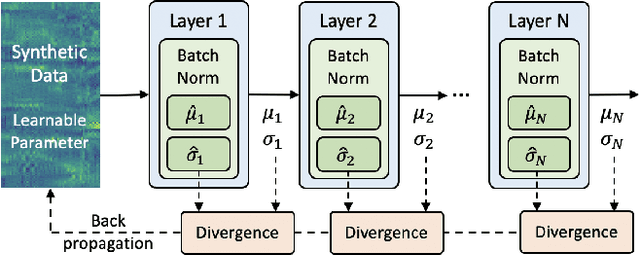
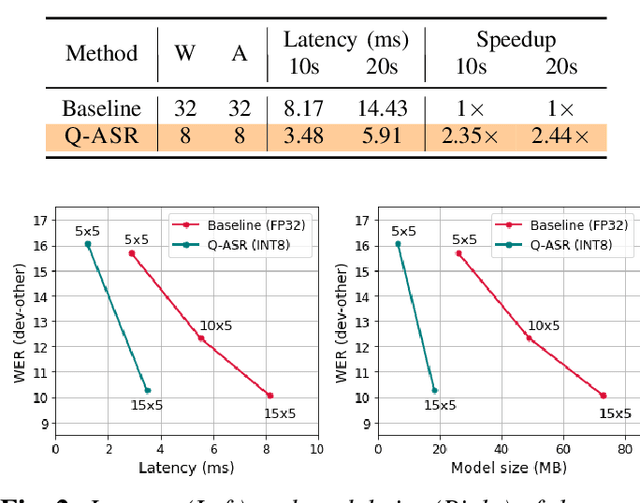
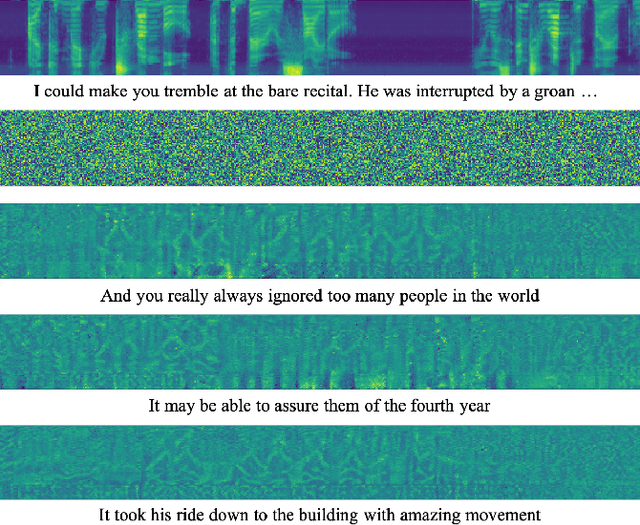
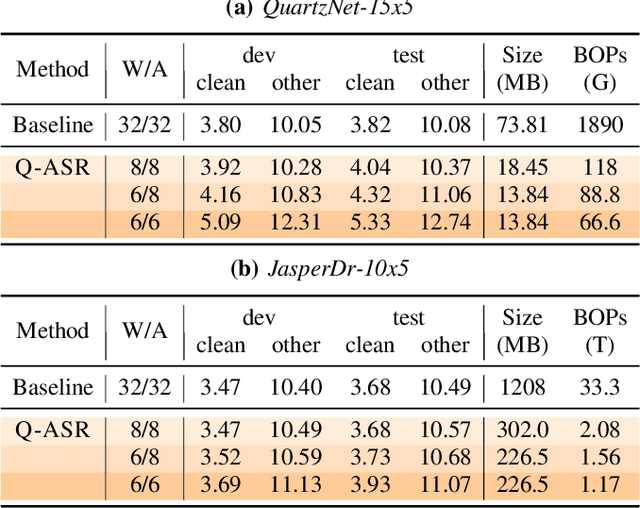
Abstract:End-to-end neural network models achieve improved performance on various automatic speech recognition (ASR) tasks. However, these models perform poorly on edge hardware due to large memory and computation requirements. While quantizing model weights and/or activations to low-precision can be a promising solution, previous research on quantizing ASR models is limited. Most quantization approaches use floating-point arithmetic during inference; and thus they cannot fully exploit integer processing units, which use less power than their floating-point counterparts. Moreover, they require training/validation data during quantization for finetuning or calibration; however, this data may not be available due to security/privacy concerns. To address these limitations, we propose Q-ASR, an integer-only, zero-shot quantization scheme for ASR models. In particular, we generate synthetic data whose runtime statistics resemble the real data, and we use it to calibrate models during quantization. We then apply Q-ASR to quantize QuartzNet-15x5 and JasperDR-10x5 without any training data, and we show negligible WER change as compared to the full-precision baseline models. For INT8-only quantization, we observe a very modest WER degradation of up to 0.29%, while we achieve up to 2.44x speedup on a T4 GPU. Furthermore, Q-ASR exhibits a large compression rate of more than 4x with small WER degradation.
A Survey of Quantization Methods for Efficient Neural Network Inference
Mar 25, 2021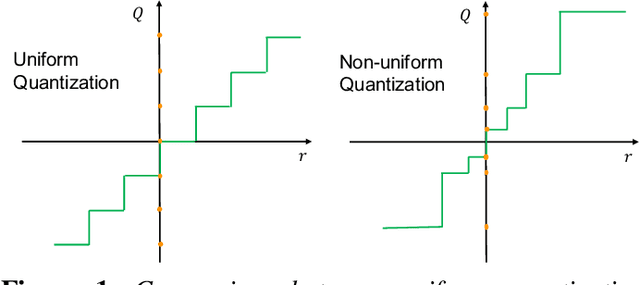

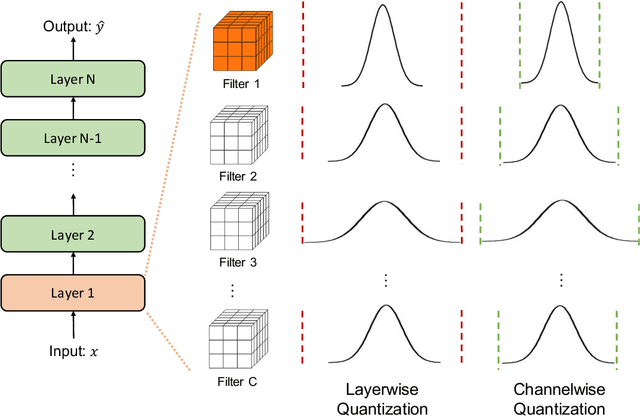

Abstract:As soon as abstract mathematical computations were adapted to computation on digital computers, the problem of efficient representation, manipulation, and communication of the numerical values in those computations arose. Strongly related to the problem of numerical representation is the problem of quantization: in what manner should a set of continuous real-valued numbers be distributed over a fixed discrete set of numbers to minimize the number of bits required and also to maximize the accuracy of the attendant computations? This perennial problem of quantization is particularly relevant whenever memory and/or computational resources are severely restricted, and it has come to the forefront in recent years due to the remarkable performance of Neural Network models in computer vision, natural language processing, and related areas. Moving from floating-point representations to low-precision fixed integer values represented in four bits or less holds the potential to reduce the memory footprint and latency by a factor of 16x; and, in fact, reductions of 4x to 8x are often realized in practice in these applications. Thus, it is not surprising that quantization has emerged recently as an important and very active sub-area of research in the efficient implementation of computations associated with Neural Networks. In this article, we survey approaches to the problem of quantizing the numerical values in deep Neural Network computations, covering the advantages/disadvantages of current methods. With this survey and its organization, we hope to have presented a useful snapshot of the current research in quantization for Neural Networks and to have given an intelligent organization to ease the evaluation of future research in this area.
 Add to Chrome
Add to Chrome Add to Firefox
Add to Firefox Add to Edge
Add to Edge